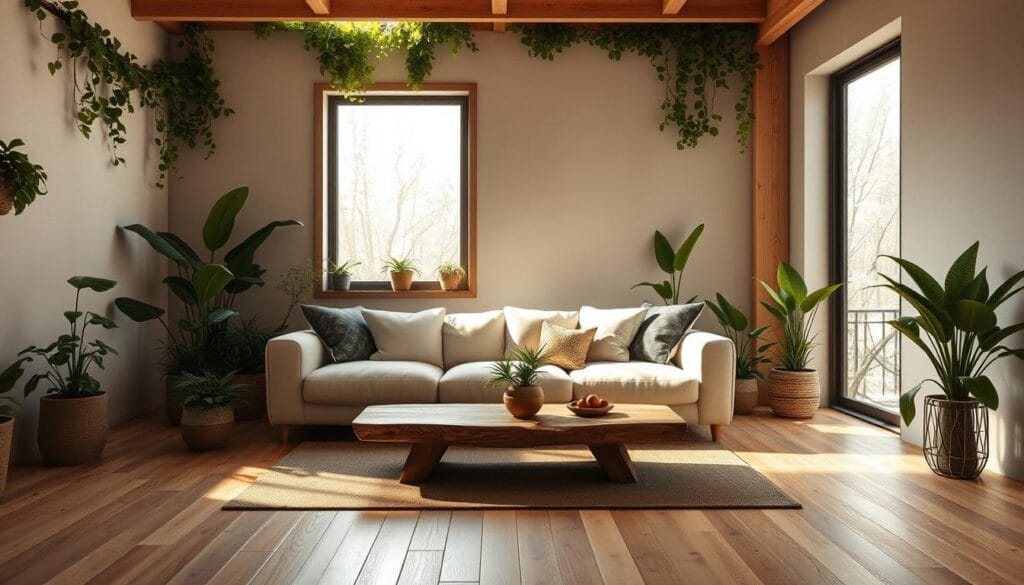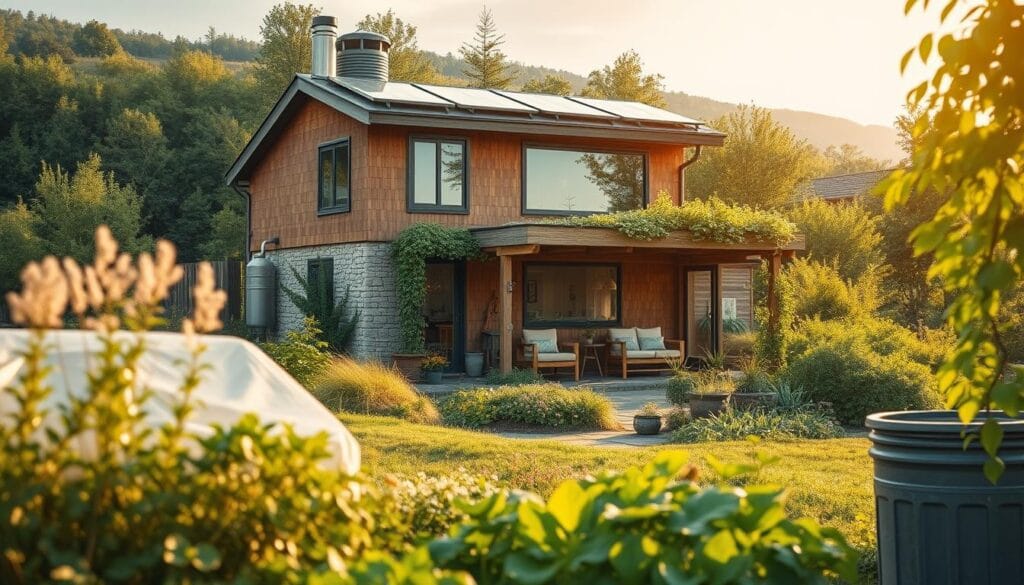Have you ever walked into a room and felt an instant sense of calm? That’s the magic of thoughtful interior design. Today, we’re blending style with care for the planet, creating spaces that feel good and do good.
Modern design isn’t just about looks. It’s about making choices that benefit both you and the world around you. From renewable materials to energy-efficient systems, every detail matters.
We’re inspired by nature-centric principles, bringing the outdoors in. Whether you’re a DIY enthusiast or a homeowner, there’s a place for you in this movement. Let’s explore how to create a sustainable interior that’s as beautiful as it is responsible.
Introduction to Sustainable Interior Design
What if your home could reflect your style while supporting the environment? That’s the essence of sustainable interior design. It’s about creating spaces that are not only beautiful but also mindful of the planet.
What is Sustainable Interior Design?
At its core, sustainable interior design is a holistic approach. It focuses on reducing the environmental impact of your space. This means choosing materials and systems that are kind to the earth. For example, low-VOC paints and energy-efficient lighting are popular choices.
This approach also considers the longevity of materials. By selecting durable items, you reduce waste and save money in the long run. It’s a win-win for both your wallet and the planet.
Environmental and Health Benefits
One of the biggest perks of this approach is improved indoor air quality. Non-toxic finishes and low-VOC products minimize harmful chemicals in your home. This creates a healthier environment for you and your family.
“Sustainable design isn’t just a trend—it’s a practical way to live better.”
Here are some key benefits:
- Reduced waste through thoughtful material choices.
- Support for local economies by using regional products.
- Lower energy bills with efficient systems.
By embracing sustainability, you’re not just designing a space—you’re making a positive impact on the world.
Sustainable Design Principles and Strategies
Transforming your space into a haven of efficiency and beauty is easier than you think. By focusing on smart choices, you can create a home that’s both functional and kind to the planet. Let’s explore some key principles and strategies to get started.
Energy Efficiency and Optimizing Natural Light
One of the simplest ways to reduce energy consumption is by maximizing natural light. Large windows and skylights can cut artificial lighting needs by up to 30%. Pair this with LED bulbs, which use 75% less energy and last 25 times longer than traditional options.
Smart thermostats are another game-changer. They optimize heating and cooling systems, saving energy and money. Energy Star appliances can also reduce usage by up to 50%, making them a practical upgrade for any home.
Waste Reduction and Material Longevity
Choosing durable materials is a cornerstone of sustainable interior design. High-quality furnishings and finishes last longer, reducing the need for replacements. This not only minimizes waste but also saves you money in the long run.
Recycled and upcycled materials are another great option. They reduce demand for virgin resources and keep waste out of landfills. For example, FSC-certified wood ensures forests are managed responsibly, while recycled glass adds unique charm to your space.
“Smart design choices today can lead to a healthier planet tomorrow.”
By adopting these practices, you’re not just creating a beautiful home—you’re making a positive impact. Small changes can lead to big results, and consistency is key. Let’s build spaces that inspire and sustain.
Key Sustainable Materials and Products
Every piece in your space tells a story—make it a sustainable one. The materials you choose can significantly impact both your home and the planet. Let’s explore the best options to create a space that’s as kind to the environment as it is beautiful.
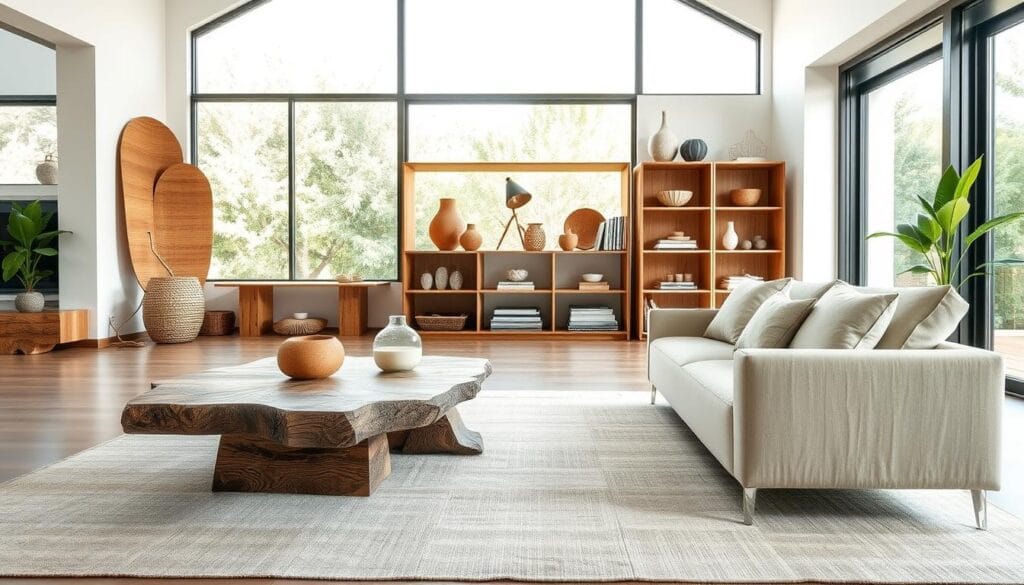
Natural and Renewable Material Choices
When it comes to sustainable materials, natural and renewable options are a top choice. Bamboo, for example, grows rapidly, making it an excellent resource for flooring and furniture. Cork is another standout, as it regenerates after harvesting, perfect for wall coverings and flooring.
Reclaimed wood is a favorite for its character and environmental benefits. By repurposing old wood, you reduce the need for new lumber, conserving forests. These materials not only look stunning but also contribute to a healthier planet.
Recycled and Upcycled Options
Recycled materials add unique charm to your space while reducing waste. Recycled glass, for instance, transforms post-consumer waste into stylish countertops and tiles. Upcycled furniture breathes new life into old pieces, creating one-of-a-kind items that tell a story.
These choices are not only eco-friendly but also cost-effective. By opting for recycled or upcycled products, you’re making a smart, sustainable choice that benefits both your home and the environment.
“Sustainable materials are more than a trend—they’re a commitment to a better future.”
| Material | Benefits | Common Uses |
|---|---|---|
| Bamboo | Rapidly renewable, durable | Flooring, furniture |
| Cork | Regenerates, soundproof | Wall coverings, flooring |
| Reclaimed Wood | Reduces deforestation, unique look | Furniture, beams |
| Recycled Glass | Reduces waste, versatile | Countertops, tiles |
Certifications like FSC and Cradle to Cradle ensure these materials meet high environmental standards. By choosing certified products, you’re supporting responsible practices and making a positive impact. Small changes in material selection can lead to big results for your home and the planet.
Innovative Eco-Friendly Design Solutions
Finding the perfect balance between aesthetics and sustainability can transform your home into a true sanctuary. Whether you lean towards a minimalist or maximalist approach, there are innovative solutions to create a space that’s both stylish and kind to the planet.
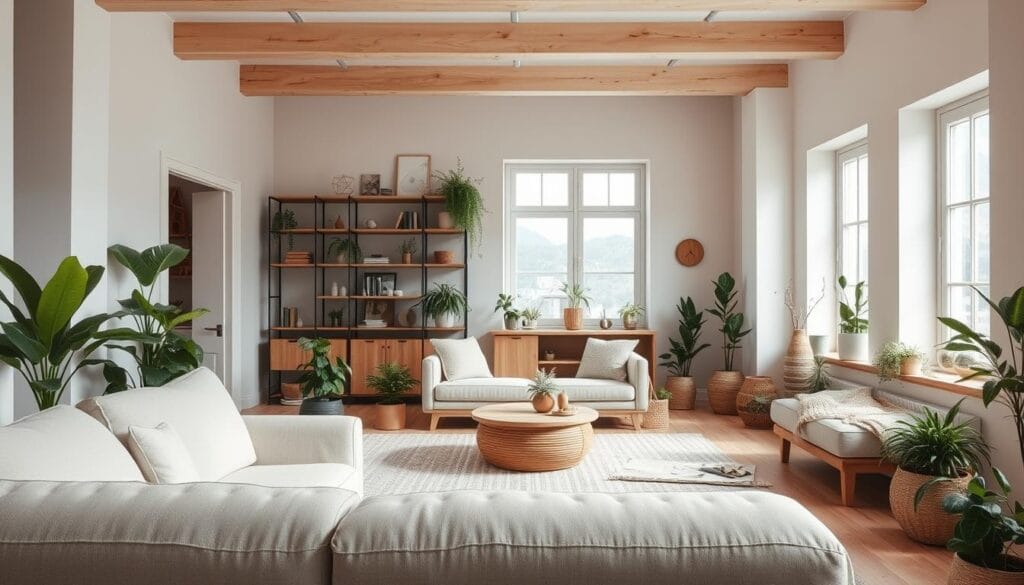
Minimalist design focuses on simplicity and functionality. It emphasizes clean lines, neutral tones, and open spaces. This approach reduces waste by using fewer materials and promotes a clutter-free environment. It’s perfect for those who value a calm and organized space.
On the other hand, maximalist design embraces bold patterns, vibrant colors, and eclectic decor. This style allows for creative expression and can incorporate upcycled or vintage pieces, giving new life to old items. It’s ideal for those who want their home to reflect their unique personality.
Minimalist vs. Maximalist Sustainable Approaches
Both styles offer unique benefits. Minimalist design reduces waste and promotes energy efficiency. Maximalist design encourages creativity and reuse. The key is to choose the right solution for your space and lifestyle.
“Sustainable design is about finding harmony between function and beauty.”
Here’s a quick comparison of the two approaches:
| Approach | Benefits | Key Features |
|---|---|---|
| Minimalist | Reduces waste, promotes calm | Clean lines, neutral tones, open spaces |
| Maximalist | Encourages creativity, reuse | Bold patterns, vibrant colors, eclectic decor |
Leading designers are merging creative style with eco-conscious practices. For example, bamboo and cork are popular choices for both minimalist and maximalist designs. These materials are not only sustainable but also add a unique touch to any space.
Integrating sustainable practices into your personal design ethos is easier than you think. Start with small changes, like choosing low-VOC paints or energy-efficient lighting. Over time, these choices will make a big impact on your home and the environment.
For more inspiration on creating a balanced home, check out our guide on organic modern design.
Integrating Energy-Efficient Systems
Imagine a home where every system works smarter, not harder, to save energy and improve comfort. From advanced HVAC systems to renewable energy sources, these solutions not only reduce consumption but also enhance your living experience.

Optimizing Indoor Air Quality and HVAC Systems
Your HVAC system plays a crucial role in maintaining indoor air quality. Modern systems with zoned controls allow you to adjust temperatures room by room, reducing energy waste. Pair this with smart thermostats, and you can save up to 15% on cooling costs.
Low-VOC materials and proper ventilation also contribute to cleaner air. These choices ensure your home is not only efficient but also healthier for you and your family.
Renewable Energy Integration
Switching to renewable energy sources like solar panels can dramatically cut your consumption. Solar power offsets traditional energy use, reducing your carbon footprint and utility bills.
Here are some practical tips for integrating these systems:
- Install solar panels to harness clean energy.
- Use energy-efficient appliances to lower consumption.
- Maximize natural light with skylights or large windows.
“Smart energy choices today lead to a greener tomorrow.”
By balancing efficiency with cost-effective measures, you can create a home that’s both functional and kind to the planet. Start small, and watch how these changes transform your space.
Smart Technology in Eco-Friendly Interiors
Smart technology is reshaping how we live, offering solutions that blend efficiency with elegance. From automated lighting to intelligent climate control, these innovations are transforming homes into spaces that are both functional and forward-thinking.
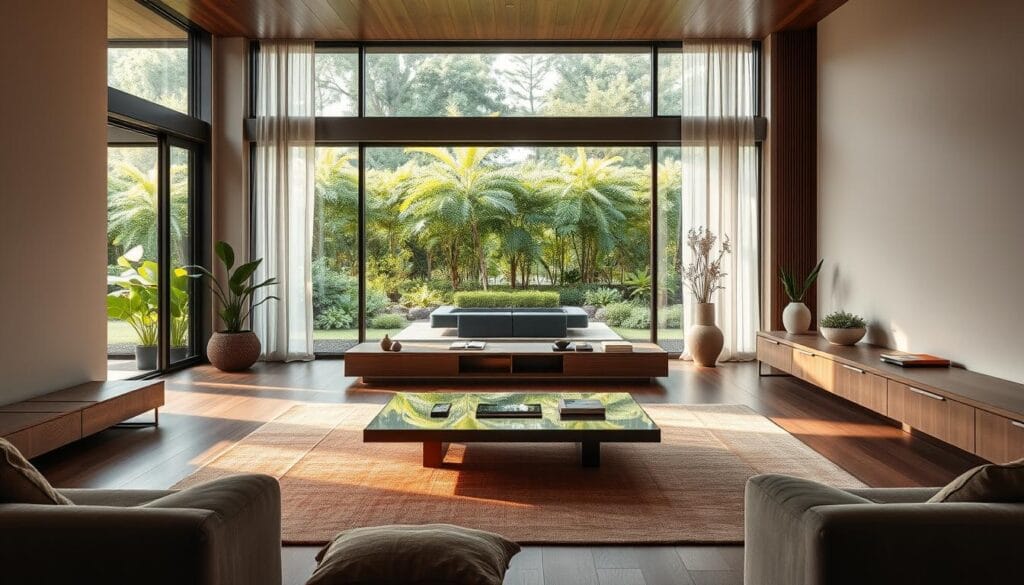
One of the most impactful advancements is in lighting. Automated systems adjust brightness based on natural light levels, reducing energy consumption while creating the perfect ambiance. Programmable thermostats take this a step further, optimizing temperature settings for comfort and efficiency.
Automated Lighting and Energy Management
Smart lighting systems are a game-changer. They allow you to customize brightness and color temperature, enhancing both usability and mood. Paired with motion sensors, these systems ensure lights are only on when needed, cutting down on unnecessary energy use.
Programmable thermostats, like Nest or Ecobee, learn your habits and adjust settings accordingly. This proactive approach not only saves money but also reduces your carbon footprint. Smart plugs and automated shades further enhance efficiency, making your home a model of modern design.
“Smart technology isn’t just convenient—it’s a practical way to live more sustainably.”
Here’s how these systems benefit your home:
- Lower energy bills through optimized usage.
- Improved comfort with personalized settings.
- Seamless integration into your interior design.
An attentive designer can combine these technologies with sustainable materials, creating a harmonious space that’s both beautiful and efficient. By embracing smart tech, you’re taking a proactive step toward a greener future.
Designing Healthy Indoor Environments
Your home should be a sanctuary where health and comfort come first. One of the most important aspects of this is ensuring good indoor air quality. Poor air can lead to discomfort and long-term health issues, but with the right practices, you can create a space that promotes well-being.

Improving Indoor Air Quality
Proper ventilation is key to maintaining clean air. Opening windows regularly allows fresh air to circulate, reducing pollutants. Adding indoor plants can also help, as they naturally filter the air. Studies show that certain plants can improve air quality by up to 87% within 24 hours.
Another effective strategy is using air purifiers. These devices remove allergens and toxins, creating a healthier environment. Pair this with regular cleaning to minimize dust and mold, and you’ll notice a significant difference in your home’s atmosphere.
Using Non-Toxic Finishes and Low-VOC Products
Choosing the right materials is essential for a toxin-free space. Low-VOC paints and finishes are a great option, as they release fewer harmful chemicals into the air. This not only improves indoor air quality but also supports your overall health.
Here are some practical tips to consider:
- Opt for natural materials like wood and stone, which are less likely to emit toxins.
- Use water-based adhesives and sealants to reduce chemical exposure.
- Look for certifications like Greenguard or Cradle to Cradle when selecting products.
“A healthy home starts with mindful choices. Every material you bring in impacts your environment.”
| Material | Benefits | Common Uses |
|---|---|---|
| Low-VOC Paint | Reduces harmful emissions, improves air quality | Walls, ceilings |
| Bamboo | Renewable, durable, non-toxic | Flooring, furniture |
| Reclaimed Wood | Eco-friendly, unique, low environmental impact | Furniture, beams |
| Natural Stone | Non-toxic, long-lasting, versatile | Countertops, flooring |
By integrating these practices into your design, you’re not just creating a beautiful space—you’re fostering a healthier lifestyle. Small changes can lead to big results, and consistency is key. Let’s build homes that inspire and sustain.
Collaborative Approaches with Sustainable Designers
Collaborating with the right professionals can turn your vision into a reality while staying true to your values. When it comes to creating a sustainable interior, working with experts who specialize in eco-friendly practices makes all the difference. These professionals bring knowledge, creativity, and a commitment to sustainability that ensures your space is both beautiful and responsible.
Selecting Professionals with Sustainable Credentials
Choosing the right designer is the first step. Look for credentials like LEED certification or specialized training in sustainable practices. These qualifications show a commitment to eco-friendly principles and ensure your project aligns with your values.
Reviewing portfolios is another essential step. A designer’s past work can give you insight into their expertise and creativity. Look for projects that prioritize renewable materials, energy efficiency, and innovative solutions. This will help you find someone who shares your vision for a sustainable interior.
Here’s what to consider when selecting a professional:
- Check for certifications like LEED or WELL.
- Review portfolios for eco-friendly projects.
- Ask about their approach to waste reduction and material selection.
“A great designer doesn’t just create spaces—they craft experiences that reflect your values and vision.”
Collaborative partnerships lead to innovative solutions. By working closely with your designer, you can ensure every detail aligns with your goals. This teamwork results in spaces that are not only efficient but also uniquely yours.
Engaging with knowledgeable professionals maximizes both design appeal and environmental benefit. They can guide you in selecting the best materials, systems, and layouts to create a space that’s both functional and kind to the planet. For more insights, explore our guide on sustainable interior design.
Real-World Examples of Sustainable Projects
Seeing real-world examples can inspire your next project. These case studies show how innovative solutions are transforming spaces while reducing environmental impact. Let’s dive into success stories that highlight the practical benefits of sustainable interior design.
Case Studies and Success Stories
One standout project is a LEED Platinum-certified home in California. It integrates solar panels, reclaimed wood, and smart technology. This approach reduced energy consumption by 40%, proving that sustainability and style can coexist.
Another example is a corporate office in New York. By using energy-efficient lighting and recycled materials, the space achieved a 30% reduction in waste. Employees also reported improved focus and comfort, showcasing the health benefits of thoughtful design.
“These projects prove that sustainable design isn’t just a trend—it’s a practical way to live better.”
Here’s a breakdown of key elements from these projects:
| Element | Benefit | Impact |
|---|---|---|
| Solar Panels | Reduces energy consumption | 40% savings |
| Reclaimed Wood | Minimizes deforestation | Unique aesthetic |
| Smart Technology | Optimizes energy use | Lower utility bills |
| Recycled Materials | Reduces waste | 30% less waste |
These examples serve as inspiration for your own home. By adopting similar practices, you can create a space that’s both beautiful and kind to the planet. Start small, and watch how these changes make a big impact.
Eco-Friendly Interiors: Designing a Stylish and Sustainable Space
Creating a space that reflects your personality while caring for the planet is easier than you think. By blending bold aesthetic choices with mindful practices, you can achieve a look that’s both chic and kind to the environment. Let’s explore how to balance style with environmental impact.
Strategies for Personalized Design
Start by selecting pieces that speak to your taste while reducing waste. For example, reclaimed wood furniture adds character and minimizes deforestation. Bamboo, a rapidly renewable resource, is perfect for flooring and decor. These choices elevate your space without compromising on quality.
Another strategy is to focus on energy-efficient lighting. LED bulbs use 75% less energy than traditional options, saving you money and reducing your carbon footprint. Pair this with natural light to create a bright, inviting atmosphere.
Examples of High-Quality, Eco-Friendly Practices
Many designers are proving that beauty and sustainability can coexist. For instance, upcycled furniture transforms old pieces into unique, stylish additions to your home. This approach not only reduces waste but also adds a personal touch to your interior.
Indoor plants are another excellent choice. They improve air quality while adding a natural element to your space. Studies show that certain plants can remove up to 87% of indoor pollutants within 24 hours.
“Thoughtful design choices can create a space that’s both beautiful and responsible.”
| Strategy | Benefit | Example |
|---|---|---|
| Reclaimed Wood | Reduces deforestation, unique look | Furniture, beams |
| Bamboo Flooring | Renewable, durable | Flooring, decor |
| LED Lighting | Energy-efficient, cost-effective | Light fixtures |
| Indoor Plants | Improves air quality, adds greenery | Decorative accents |
By integrating these practices, you can create a space that’s both visually appealing and eco-conscious. Small changes lead to big results, and consistency is key. Let’s build homes that inspire and sustain.
Budget-Friendly Tips and DIY Solutions
Transforming your home doesn’t have to break the bank—let’s explore budget-friendly ways to refresh your space. With a little creativity, you can achieve a stylish look while minimizing waste and cost. Here’s how to make the most of what you already have.
Innovative Upcycling and Reuse Ideas
Upcycling is a fantastic way to breathe new life into old items. Turn an outdated piece of furniture into a statement item with a fresh coat of paint or new hardware. For example, an old dresser can become a chic TV stand with minimal effort.
Repurposing materials is another great solution. Use leftover wood to create shelves or picture frames. This not only reduces waste but also adds a personal touch to your space.
“Upcycling isn’t just about saving money—it’s about creating something unique and meaningful.”
Cost-Effective Eco-Friendly Materials
Choosing the right materials can make a big difference. Bamboo and cork are affordable, renewable options that add natural beauty to your home. Reclaimed wood is another excellent choice, offering character and environmental benefits.
Here’s a quick guide to cost-effective materials:
| Material | Benefit | Use |
|---|---|---|
| Bamboo | Renewable, durable | Flooring, decor |
| Cork | Soundproof, eco-friendly | Wall coverings, flooring |
| Reclaimed Wood | Unique, reduces waste | Furniture, accents |
Incorporating plants is another budget-friendly tip. They improve air quality and add a fresh, natural element to your space. Choose low-maintenance options like succulents or snake plants for easy care.
Small changes, like switching to energy-efficient lighting, can also make a big impact. LED bulbs use less energy and last longer, saving you money over time. Pair these with water-efficient fixtures to further reduce your consumption.
By adopting these practices, you can create a space that’s both stylish and kind to the planet. Start small, and watch how these changes transform your home.
Conclusion
Crafting a home that aligns with your values while caring for the planet is both achievable and rewarding. By blending innovative technology with thoughtful material choices, you can create a space that reflects your style and supports the environment.
This approach not only reduces environmental impact but also enhances the quality of your daily life. From energy-efficient systems to upcycled furniture, every option contributes to a healthier, more enjoyable living space.
We encourage you to explore sustainable interior solutions that fit your lifestyle. With creativity and practical tips, you can build a home that feels uniquely yours while making a positive impact. For more inspiration, check out our guide on sustainable interior design.
Let’s create spaces that inspire and sustain—one thoughtful choice at a time.

